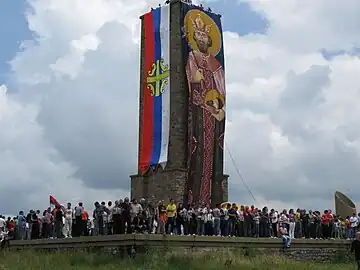| Vidovdan | |
|---|---|
 2009 Vidovdan celebration at Gazimestan monument | |
| Observed by | Serbs (Serbian Orthodox) |
| Observances | Feast day |
| Date | 28 June (Gregorian calendar) 15 June (Julian calendar) |
| Frequency | Annual |
| Related to | Slava |
Vidovdan (Serbian Cyrillic: Видовдан, lit. "Saint Vitus Day") is a Serbian national and religious holiday, a slava (feast day) celebrated on 28 June (Gregorian calendar), or 15 June according to the Julian calendar. The Serbian Church designates it as the memorial day to Saint Prince Lazar and the Serbian holy martyrs who fell during the Battle of Kosovo against the Ottoman Empire on 15 June 1389 (according to the Julian calendar). It is an important part of Serb ethnic and Serbian national identity.[1]
History

The day became highly regarded by Serbs after the fourteenth century when the Battle of Kosovo took place on Saint Vitus Day in 1389.[2] A Serb-led Christian coalition by Prince Lazar fought the Ottoman army on the Kosovo field.[3] Although the battle itself was inconclusive, and both Sultan Murad and Prince Lazar were slain, it led to the Ottoman conquest of Serbian principalities.[4] After the Great Migrations of the Serbs in 1690, Vidovdan became a day to honor those who fought in the battle and fell "for their faith and homeland".[5] The holiday was institutionalized by the church in 1849 and politically and publicly first celebrated in 1851 as a representation of the struggle for Serbian freedom from Ottoman subjection.[5] It slowly achieved popularity with the growth of national identities in Europe in the nineteenth century and came to be known as a day of remembrance. After 1918, the Yugoslav government designated Vidovdan as a day of remembrance to honor all those who died in war, particularly those of the Balkan Wars and World War I.[6][7]
There are significant events which coincidentally or intentionally occurred on June 28:[8]
- Serbian declaration of war against the Ottoman Empire in 1876
- Signing of the Austro–Serbian Alliance of 1881
- Assassination of the Austro-Hungarian crown prince, Franz Ferdinand by Gavrilo Princip in 1914 which triggered the First World War
- Signing of the Treaty of Versailles in 1919
- The Serbian King Alexander I's proclamation of the new 1921 Constitution of the Kingdom of Serbs, Croats and Slovenes, known thereafter as the Vidovdan Constitution (Vidovdanski ustav).
- The Cominform Resolution calling for regime change in Yugoslavia is published in 1948 on Soviet initiative.
- On the 600th anniversary of the battle of Kosovo, Serbian leader Slobodan Milošević delivered the Gazimestan speech on the site of the battle. This was the first public celebration of Vidovdan since the Yugoslav communist era.[8]
Beginning in the late 19th century, Serbian publications began to appear in Serbian literature promoting the idea that the holiday originated from the Slavic god Svetovit. The first to put forth such a view was Natko Nodilo, who attributed the cult of Svetovit to all Slavs, whose worship in Serbia was later deliberately replaced by that of a saint with a similar name. This view was supported by some later researchers. However, it is generally believed that the cult of Svetovit existed only among the Polabian Slavs and that Vidovdan has nothing to do with this god, and that linking the deity to the holiday is a creation of romanticism.[9][10]
References
- ↑ Đorđević 1990.
- ↑ Banac, Ivo (1988). The National Question in Yugoslavia: Origins, History, Politics (Second ed.). Cornell University Press. p. 403. ISBN 9780801494932.
- ↑ Norris, David A. (2009). Belgrade: A Cultural History. Oxford University Press. p. 9. ISBN 9780195376081.
- ↑ Trbovich, Ana S. (2008). A Legal Geography of Yugoslavia's Disintegration. Oxford University Press. p. 70. ISBN 9780195333435.
- 1 2 Velikonja 2003, p. 99.
- ↑ Bokovoy, Melissa (2001). Bucur, Maria; Meriwether Wingfield, Nancy (eds.). Staging the Past: The Politics of Commemoration in Habsburg Central Europe, 1848 to the Present. Purdue University Press. p. 253. ISBN 9781557531612.
- ↑ Boeckh, Katrin; Rutar, Sabine, eds. (2017). The Balkan Wars from Contemporary Perception to Historic Memory. Springer. p. 263. ISBN 9783319446424.
- 1 2 Kühle, Lene; Lausten, Carsten Bagge (2006). Kosovo between War and Peace: Nationalism, Peacebuilding and International Trusteeship. Routledge. pp. 24–26. ISBN 9780415459587.
- ↑ Miodrag 2007, p. 47-49.
- ↑ Katičić 2010.
Sources
- Đorđević, Dimitrije (Spring 1990). "The role of St. Vitus Day in modern Serbian history" (PDF). Serbian Studies. North American Society for Serbian Studies. 5 (3): 33–40. Archived from the original (PDF) on 24 September 2015. Retrieved 16 May 2015.
- Katičić, Radoslav (2010). "Vidova gora in sveti Vid". Studia mythologica Slavica (in Croatian). 13: 15–32. doi:10.3986/sms.v13i0.1637. ISSN 1581-128X.
- Miodrag, Marković (2007). "Култ светог Вита (Вида) код Срба у средњем веку". Зограф: часопис за средњовековну уметност (in Serbian). Belgrad: Филозофски факултет Институт за историју уметности. 31: 35–50. ISSN 0350-1361.
- Šijaković, Bogoljub. "The Great War, ethics of Vidovdan, memory." Zbornik Matice srpske za drustvene nauke 150 (2015): 1–42.
- Rakočević, Novica (1997). Crna Gora u prvom svjetskom ratu, 1914–1918. Unireks. ISBN 9788642705835.
- Velikonja, Mittja (2003). Religious Separation and Political Intolerance in Bosnia-Herzegovina. Texas A&M University Press. ISBN 978-1-60344-724-9.
External links
- News articles
- "What is Vidovdan, and why is it so important to Serbs?". B92. 22 June 2012.
- "Serbian War Vets Celebrate Vidovdan". Balkan Insight. 29 June 2012.
- Graham, Stephen (1930). St. Vitus Day. E. Benn.



